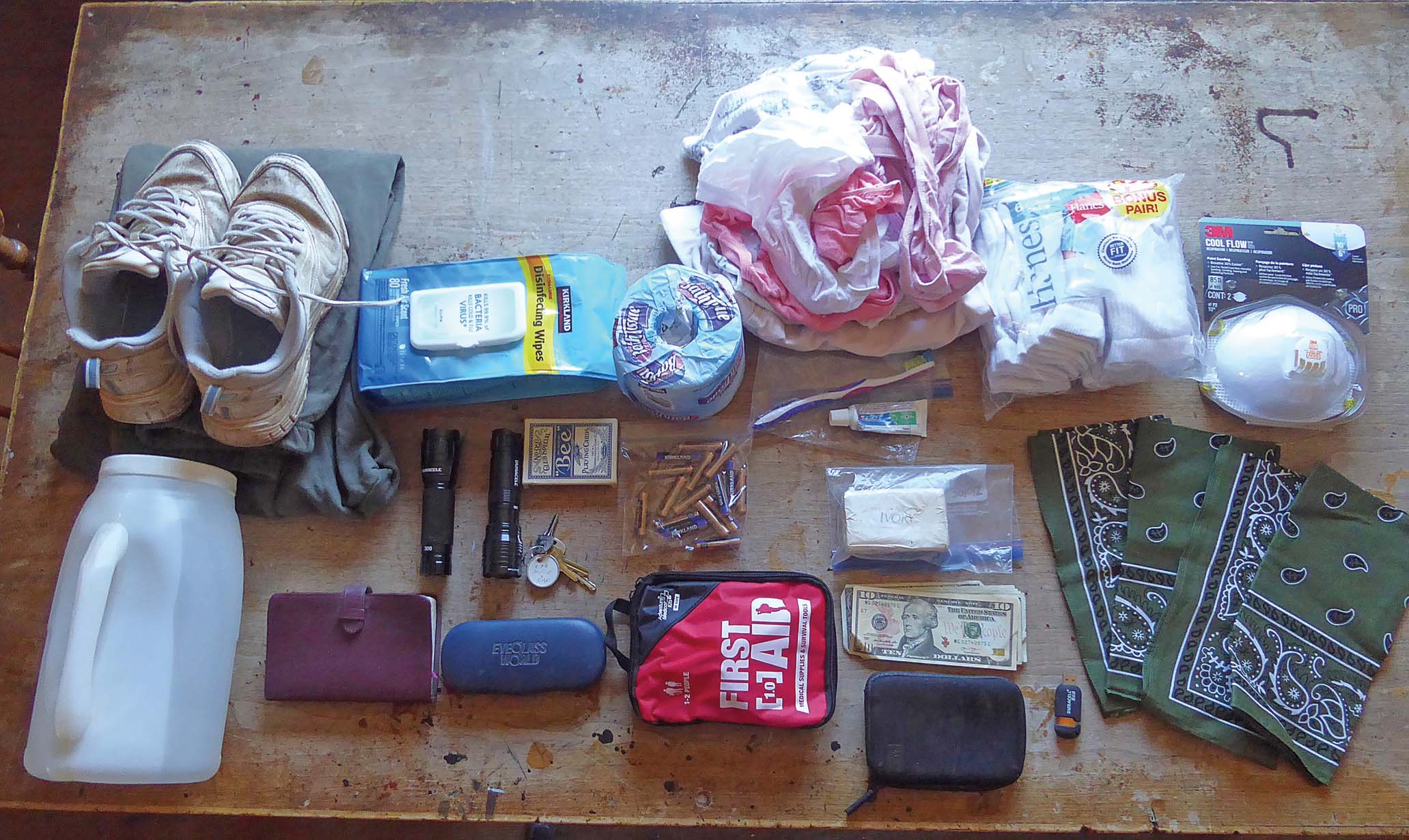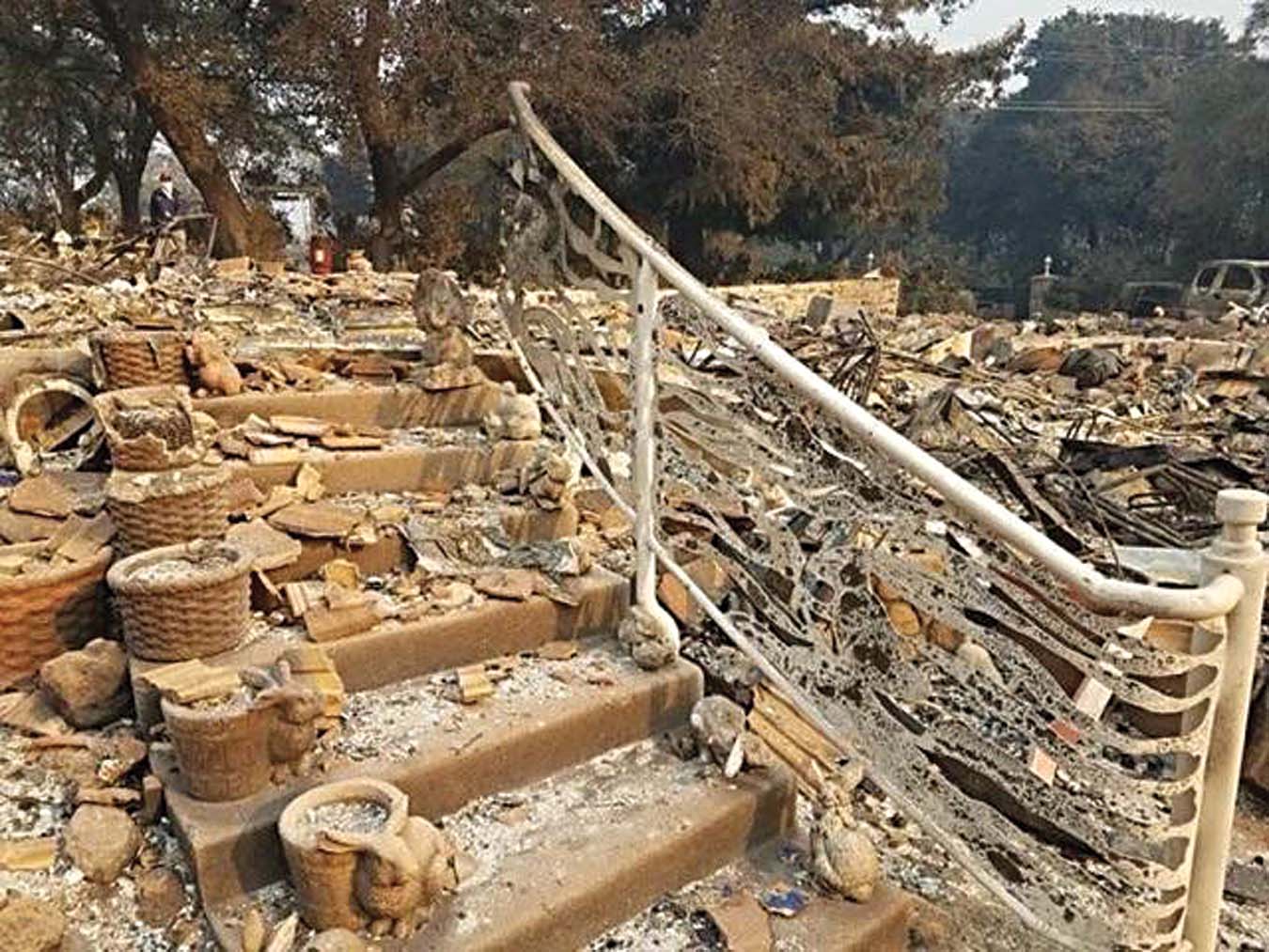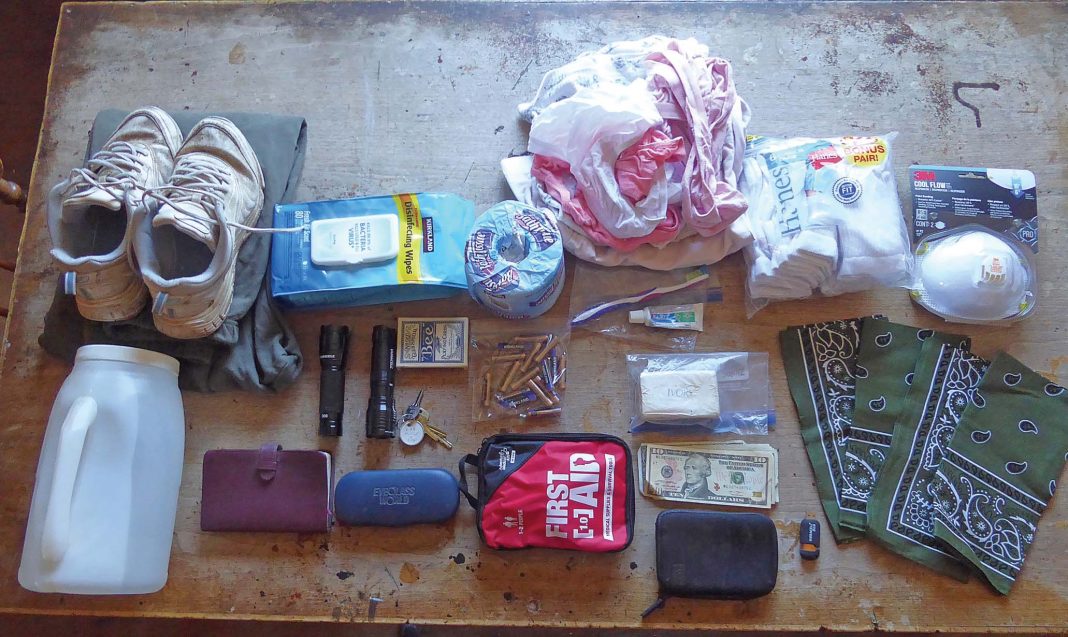By Patrice Lewis
In October 2017, the neighborhood I grew up in was incinerated by a wildfire. It was one of many during a devastating fire season. My parents had long since retired and moved elsewhere, but it was sad to know all my childhood haunts had gone up in smoke, along with homes, wildlife, livestock, and memories.
Many of the fires started in the middle of the night and spread so quickly that those who were able to escape often did so with very little warning. We have friends who escaped with their dogs and the clothes on their backs — nothing else.
Even though we’ve been threatened by wildfires before, suddenly in my mind these disasters were no longer just theoretical events that sometimes made it to the evening news. They were real, sudden, and deadly.
Though wildfires are a common occurrence in western states, it was the sight of our friends’ leveled home (and the knowledge that my childhood neighborhood was destroyed) that galvanized me into doing something we should have done years before: assembling a wildfire bug-out bag.
What a wildfire bug-out bag is not
In the prepper world, bug-out bags have achieved a sort of mythical status. There are hundreds of pre-made grab-n-go kits on the market. Whole books, websites, and blogs are dedicated to what should go into bug-out bags so you’ll be equipped to handle everything from fighting off gang members to deep-sea fishing (even if you’re situated in Nebraska). These bags often have a twinge of zombie-apocalypse mentality associated with them — the idea that we should all be ready, willing, and able to don a 40-pound backpack and slink out of urban areas, dodging those pesky zombies with clever ninja paramilitary maneuvers, until we ultimately end up in our pre-prepared rural homestead where we’ll, I dunno, live happily ever after or something.
A wildfire bug-out bag is none of those things. The goal of this type of bug-out bag is to allow you to evacuate your home in the most rapid and efficient method possible, while retaining critical items that you will need for both immediate needs and long-term negotiation as you pull your life back together.

Contents of our grab ‘n’ go bag, including water, digital backups of our computers, scanned documents and photos, spare glasses and prescriptions, toilet paper, shoes and socks, flashlights, and other items outlined in this article.
When evacuating before a wildfire, you are not planning on dodging zombies and camping in the wilderness while you trek to your rural cabin. Instead, you’re fleeing a rural or semi-rural area toward the assistance of other people, where (hopefully) your immediate needs of food, water, and shelter will be addressed. With that in mind, the importance of tents, sleeping bags, camp stoves, dehydrated food, and other camping supplies is significantly lower. Instead, think what portable things you would be devastated to lose; think what documentation might help you get back on your feet and deal with banks, insurance agencies, and other bureaucratic necessities; and think what personal clothing and sanitation needs would allow you some measure of comfort and dignity for a few days.
Freezing up
Why is a bug-out bag necessary? Why not just have a list of things to pack? Aside from the very real possibility of a lack of time, one of the problems with an urgent emergency situation is people have a tendency to panic and freeze up. Either they do nothing, or they gather unnecessary and inappropriate things to take with them. A pre-packed bug-out bag eliminates some of the worry associated with this tendency.
Attached to the bug-out bags should be a list of items you don’t want to forget but shouldn’t be packed ahead of time, since they’re commonly used, such as prescription medicines, personal electronics and chargers, keys, jewelry, etc.
Additionally, the list should include action items to do — time permitting — to secure your home against greater damage, such as turning off utilities (electricity, water, gas) and locking your doors.
The Five Ps
The rule of thumb for emergency evacuations, in order of importance, are the five Ps: People, Pets, Prescriptions, Photos, and Papers. Clearly this list is vastly oversimplified, but it’s a starting point.
Obviously, you won’t be putting people or pets into a bug-out bag. Prescriptions are a good possibility, but only if you have sufficient extras that you can stash some in the bag (talk to your doctor and rotate your supply). Therefore much of the bug-out bag will concentrate on photos, papers, and immediate necessities.
Let’s talk photos
Photos are something everyone would be devastated to lose. Today, most people have the bulk of their photos digitized, which means it’s a simple matter to back up photos onto an external hard drive or USB drive. But for those of us old fuddy-duddies who originated back in the Stone Age of print photos, we often have large quantities of pictures we would hate to lose: photos of beloved deceased family members, pictures of our kids as babies, places we used to live, wonderful vacations we took. For these treasured relics, it’s time to bite the bullet and get them digitized as a backup.
There are a number of photo scanning options now available, ranging in size (and price) from small handheld devices to large flatbed scanners. Many new home printers now have a built in scanner as well. You can even bring photos in to be scanned professionally (particularly if they’re oversized or damaged in some way).Whatever it costs, the price and effort is negligible next to the tragedy of losing these treasured mementos.
In my case, the bulk of my digital photos are on an external hard drive, so it was a simple matter to duplicate them onto another hard drive and keep that in our bug-out bag. However I also had two dozen photo albums from my youth, college days, our wedding, and our daughters’ childhoods I couldn’t bear to lose; over a period of months I took a walk down memory lane and scanned these photos into digital format. The sense of relief at having these in redundant form was enormous.

All that was left of our friends’ home, October 2017 wildfire
Photograph your home
It is critical to have your home photo-documented for insurance purposes. I don’t mean you just stand in the corner of a room and take a panoramic shot; that’s only the beginning. I mean, you open every drawer and cabinet, cupboard and closet, and document the contents. For some higher-end items (such as personal electronics, jewelry, firearms, etc.), you may need satisfactory documentation proving ownership and value. There will likely be limitations in your insurance policy for specific items, so that’s something to be aware of.
In reading some material by a former insurance claims adjuster on how claims are decided, it’s amazing how much insurance companies will try to assert your possessions are of the lowest-possible quality so they can get away with making inexpensive replacements. Depending on the type of insurance you have, insurance agencies may be obliged to replace an item, but they’re not necessarily obligated to replace it with an item of identical quality and value. If your refrigerator is a top-of-the-line designer model with a built-in Keurig coffee maker and Wi-Fi capabilities, you won’t be pleased if they offer to replace it with an inexpensive Wal-Mart special.
So it’s up to you to document everything of value in your home. Take a picture of your fancy refrigerator and make sure the make and model is noted. You should have photos of your furniture, carpeting, wall decorations, clothing, book collection, kitchenware, washer and dryer, treasured knick-knacks, and all the other possessions with which the typical home is stuffed. (In the process, you might discover it’s time to declutter as well.)
Clearly an insurance company may not feel compelled to replace your beer bottle-cap collection, but it’s very important for you to be able to justify your requests for replacement value of household items. If you can’t prove you once owned a top-of-the-line designer refrigerator with a built-in Keurig coffee maker and Wi-Fi capabilities, then you can hardly expect the insurance company to willingly replace it.
Then you need to step outside your house and document everything else as well. Barns, shops, vehicles, livestock, property … all this is necessary for insurance companies to decide a claim. The more detailed information you can provide, the better your chances to argue for a fair settlement.
Document document document! You can’t do enough of it. And all that documentation should be digitized and redundant — a copy in your bug-out bag, and possibly another copy with a friend, relative, or in a safety deposit box.
Your papers please
Even in paperless homes, there are many vitally important documents you seldom need but are vitally important. Copies of these documents should be digitized and kept in your bug-out bag.
The chaos of fleeing from an enormous regional natural disaster is unmatched. After the horror of Hurricane Katrina, I heard stories of people separated for months because they didn’t have any way to get hold of each other. Not many people had the documentation necessary to even prove they owned a piece of property, never mind the contents of their homes.
If you are utterly stripped of all identifying documentation, how do you prove you’re you? Can you walk into a distant branch of your bank and withdraw money? Can you contact critical agencies such as Social Security, insurance, and healthcare in order to obtain services?
To this end, have digitized versions of as many documents as possible in your bug-out bag, including:
- Birth certificates
- Social security numbers
- Driver’s licenses
- Concealed-carry permits
- Military discharge papers
- Marriage license
- Bank statements/account numbers
- Copies of tax returns for previous seven years
- Utility statements/account numbers
- Mortgage papers/house deed
- Will or trust documents
- Passports
- Children’s immunization records
- Insurance documents
- Passwords for computers, accounts, social media, etc.
- Contact information for friends/relatives (addresses, phone numbers, email)
Some people may prefer to have all this information on the cloud or in their smart phones, and that’s fine, but think redundancy as well as security. I prefer not to have personal information on the cloud, and we don’t own smart phones, so instead we have all these documents digitized and saved on thumb drives.
Computer backup
As a writer, I have a great deal of essential material on my laptop I would be devastated to lose.
I use an external hard drive and back up my computer about once a month (and sometimes specific files to a thumb drive more often than that). This hard drive has enough room to store my computer files, scanned important documents, and digitized photos.
Other stuff
If you’re fleeing your home in a hurry, you have no time to dress properly or do much more than grab your children and pets. This is what happened to our friends whose home was utterly destroyed; they fled barefoot in the middle of the night in their nightclothes with their dogs. They lost everything else. They had no shoes or warm clothing. You may not be planning to camp in the wilderness for days on end, but there are some things that would be helpful to have in your grab-and-go bag.
Therefore some additional things for your bug-out kit could include:
- Spare car keys
- Flashlights, extra batteries
- First aid kit
- Infant formula, can opener, bottles (if necessary)
- Sanitation and toiletry supplies (diapers, feminine hygiene, wet wipes, soap, toothbrush, etc.)
- Shoes, clothing
- Money (small bills)
- Spare eyeglasses, contact lenses, contact solution
- Bandanas (for all-purpose needs ranging from wiping noses to breathing filter)
- Non-perishable snacks, such as granola bars
- Wrench or pliers to turn off utilities
- Masks and goggles for nose/eye smoke protection (N-95 or N-100 masks recommended)
- One gallon of water per person
- Diversions, such as a deck of cards, small Bible, etc.
There are other items you may not want to pack permanently in a bug-out bag, but should slip in if you have time. Jewelry, cell phones, and prescription medicines are all things you don’t want to lose (you’ll have your own list of important items). These should all be written down on a list clipped to your bug-out bag. If you have time, go down the list and grab the additional items and/or perform the additional tasks before leaving your home.
What kind of bag?
What sort of bag should you use? The solution depends on a number of variables. How many family members do you have? What are their ages and health? Do you anticipate evacuating on foot or by vehicle?
To help determine the size and style bag you need, assemble all the contents together and see how much space you need. Most photos and documents, if digitized, will be compact and easy. The bulk of the space will likely be filled by spare clothes, shoes, and sanitary needs.
Children should have their own bug-out bags. Obviously theirs is unlikely to contain vital paperwork or prescription medicines, but it would be comforting to know they have their own clothing, shoes, and a consoling toy or two during a time of crisis.
If you have time
Not every evacuation occurs with a two-minute warning. Sometimes you have hours or days to prepare to leave your home.
While this may seem like a huge help, the “freeze up” tendency can sometimes paralyze people even then. I remember reading an article about how a newly married young woman faced an oncoming wildfire while her husband was away. Even though she had several hours to prepare, she walked in dazed circles around their new home, watched some television, weeded a flower bed, and did nothing constructive. Then suddenly she had to evacuate in a hurry, and there was no more time to save anything. They lost it all.
This is why having a pre-packed bag as well as a list of concrete things to do helps break a frozen mind out of its paralysis.
Just Do It
I’ll confess a secret: despite the fire that wiped out my childhood home, I still didn’t pull together a bug-out bag until I started writing this article. Now our bag is hanging on a coat hook by our front door, ready to grab at a moment’s notice. There is enormous peace of mind contained in that little bag.
The biggest — THE BIGGEST — obstacle to packing a bug-out bag for emergency evacuations is simply laziness and inertia. Yes, it’s work … but reassembling your life after losing your home to a wildfire is vastly more difficult; a prepared grab and go kit containing backups of your important documents and irreplaceable photos and other items can help take the burn out of such a huge loss.













